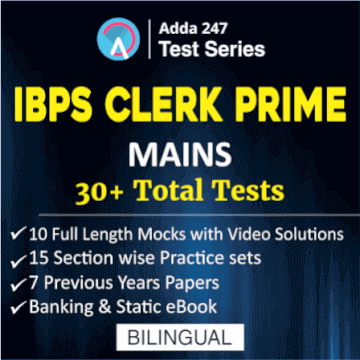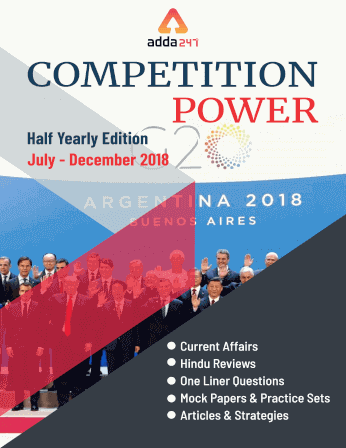English Language Quiz For IBPS Clerk Mains
IBPS had conducted the IBPS Clerk Prelims Exam few weeks ago and the result will be out shortly. Now the next step is to clear the mains exam Thus, the English Language can be an impetus for their success by helping them save crucial time and score good points in lesser time and effort. So, instead of boiling the ocean, try building up a strong vocabulary, an effective knowledge of grammar, and efficient comprehension skills so as to be on the ball to face this particular section. Here is a quiz on English Language being provided by Adda247 to let you practice the best of latest pattern English Questions for IBPS Clerk Mains Exam.
Directions (1-10): Read the given passage and answer the questions as directed.
Delhi in the cooler months, between early October and late March, once a six-month stretch of mild sunshine, blue skies, crisp air, festivals of every major religious community, associated with agricultural cycles, equinoxes and other natural and cultural punctuations of the annual solar calendar (A) ………………… with the monthly lunar calendar, lives now only in memory. (B) A pall of the world’s worst air pollution descends on the city at the beginning of what used to been the festive season, and lifts only, if at all, as the harsh summer approaches, bringing with it its own problems of excessive heat and water scarcity. (C) Our lifespans have been shortened, we are told, by sustained exposure to various pollutants, but things have relief a stage where one can only see this as a reached from having to live on in a place no longer fit for human habitation. We cough, gasp and (D)……………………………………………………….. these punishing winter months, with poor visibility, skies neither blue nor sunny, and a feeling of being trapped in a long nightmare from which we cannot awaken. A public health emergency (E)………… us all, from children with permanently compromised respiratory systems to the elderly struck by lung cancer towards the end of their lives. (F) The persistent itch in our throats and the dull ache in our heads will not go away for weeks one day. Mornings and evenings are unsafe for walks; any outdoor activity (G)……………… the use of masks if not inhalers; natural light can only be seen when one leaves town. Eerily simultaneously, a political fog descended on the capital in 2014. In late August Ashis Nandy delivered the Daya Krishna Memorial lecture in Delhi, titled “Lost Cities and Their Inhabitants”. He was careful to define and (H) delineate what he meant by “lost”. A “lost city” is one whose past one can remember and relate to; one whose memory as a living city is not overwritten by an episode of final destruction. (I) Thus Hiroshima is not a lost city, since it was completely destroy in the form in which it had existed by the detonation of an atomic bomb in August 1945. A city may be called lost when people remember its life and not its death. (J) The city as it continues to be and the city’s lost self are, in a sense, discontinuous with one another. Lost cities are autonomous, to use Prof. Nandy’s term, from their real counterparts. He spoke about Bombay and Jerusalem, Cochin and Dhaka, Lahore and Hyderabad, Calcutta and Lucknow. Needless to say, histories of war, genocide and mass migration are implicit in the stories of these cities, and many others in the world, ancient as well as modern
Q1. Which of the following word given in the options should come at the place marked as (A) in the above paragraph to make it grammatically correct and meaningful. Also, the word should fill in the two sentences given below to make them contextually correct and meaningful.
(i) Rissa was dressed in clean men's clothing, her hair ……………. once more.
(ii) She had stolen a …………………. rug from the foot of his own bed and a rocking chair from the garage.
handled
curtail
braided
hampered
None of the Above
Solution:
Braided: interlace three or more strands of (hair or other flexible material) to form a length.
Q2. In the passage given, a sentence (B) is given in italics. There may or may not be an error in one part of the sentence. Choose the part which has an error in it as your answer. If there in no error then choose option (e) as your answer
A pall of the world’s worst air pollution descends on the
city at the beginning of what used to been the festive season,
and lifts only, if at all, as the harsh summer approaches,
bringing with it its own problems of excessive heat and water scarcity.
No change required
Solution:
Use 'be' and not 'been' with 'to'.
Q3. The sentence given in (C) has four words given in bold. Amongst the given bold words which of the following must replace each other to make the sentence contextually correct and meaningful.
sustained-habitation
reached-habitation
sustained-relief
reached-relief
No change required
Solution:
reached-relief
Q4. Which of the following phrases should fill the blank in (D) to make it contextually correct and meaningful?
prefer eating to exercising
refuse taking the medicines
choke our way through
do not prefer to visit
None of the Above
Solution:
'choke our way through' is grammatically and contextually correct here.
Q5. Which of the following words should come in the blank given in (E) in the passage?
dehydrates
engulfs
overwhelming
endanger
soothe
Solution:
Engulf: powerfully affect (someone); overwhelm.
Q6. In the passage given, a sentence (F) is given in BOLD. There may or may not be an error in one part of the sentence. Choose the part which has an error in it as your answer. If there in no error then choose option (e) as your answer.
The persistent itch in our
throats and the dull ache in our
heads will not go away
for weeks one day.
No change required
Solution:
No change required
Q7. Which of the following word given in the options should come at the place marked as (G) in the above paragraph to make it grammatically correct and meaningful.
endanger
protects
endeavour
necessitates
remark
Solution:
'necessitates' is the correct choice for the blank.
Q8. Which of the following words given in the options, is opposite in meaning to the word given in bold in (H) in the above paragraph.
falsify
illustrate
represent
sketch
limn
Solution:
Delineate: describe or portray (something) precisely.
Q9. In the passage given, a sentence (I) is given in italics. There may or may not be an error in one part of the sentence. Choose the part which has an error in it as your answer. If there in no error then choose option (e) as your answer.
Thus Hiroshima is not a lost city, since
it was completely destroy in the form
in which it had existed by the detonation
of an atomic bomb in August 1945.
No error
Solution:
Use 'destroyed' as the sentence is in past tense.
Q10. The sentence given in (J) has four words given in bold. Amongst the given bold words which of the following must replace each other to make the sentence contextually correct and meaningful.
self-discontinuous
autonomous-real
self-real
discontinuous-autonomous
No change required
Solution:
No change required
Directions (11-15): In the passage given below there are blanks which are to be filled with the options given below. Find out the appropriate word in each case which can most suitably complete the sentence without altering the meaning of the statement.
Q11. The World Human Rights day has just turned seventy. Isn’t this the time to evaluate the journey in …………(11)………… of goals enshrined in the charter, for women in particular? The post-UN era undoubtedly witnessed the emergence of many gender-specific resolutions to do away with ………..(12)………….. and violence. In the new millennium, the Millennium Development Goals (MDGs), and subsequently, the ongoing Sustainable Development Goals (SDGs) also contain a ………(13)……….. agenda for women by 2030. The outcome analysis of the MDGs in 2015, revealed a story of mixed global progress in several human development indicators. The literacy rate among women (15 to 24 years) showed an ………(14)…………. turn from 83 to 91 per cent, between 1990 and 2015. But women continued to remain on the …………(15)………… of political power by being only one among five members of parliament, notwithstanding their enhanced presence from 13.2 per cent in 2000 to 23.4 per cent in 2017 (UN Women).
aware
realisation
devastation
recruitment
Both (b) and (d)
Solution:
Realisation: the achievement of something desired or anticipated.
Q12. The World Human Rights day has just turned seventy. Isn’t this the time to evaluate the journey in …………(11)………… of goals enshrined in the charter, for women in particular? The post-UN era undoubtedly witnessed the emergence of many gender-specific resolutions to do away with………..(12)………….. and violence. In the new millennium, the Millennium Development Goals (MDGs), and subsequently, the ongoing Sustainable Development Goals (SDGs) also contain a ………(13)……….. agenda for women by 2030. The outcome analysis of the MDGs in 2015, revealed a story of mixed global progress in several human development indicators. The literacy rate among women (15 to 24 years) showed an ………(14)…………. turn from 83 to 91 per cent, between 1990 and 2015. But women continued to remain on the …………(15)………… of political power by being only one among five members of parliament, notwithstanding their enhanced presence from 13.2 per cent in 2000 to 23.4 per cent in 2017 (UN Women).
discrimination
appreciation
encroachment
freedom
abetment
Solution:
Discrimination: the unjust or prejudicial treatment of different categories of people, especially on the grounds of race, age, or sex.
Q13. The World Human Rights day has just turned seventy. Isn’t this the time to evaluate the journey in …………(11)………… of goals enshrined in the charter, for women in particular? The post-UN era undoubtedly witnessed the emergence of many gender-specific resolutions to do away with………..(12)………….. and violence. In the new millennium, the Millennium Development Goals (MDGs), and subsequently, the ongoing Sustainable Development Goals (SDGs) also contain a ………(13)……….. agenda for women by 2030. The outcome analysis of the MDGs in 2015, revealed a story of mixed global progress in several human development indicators. The literacy rate among women (15 to 24 years) showed an ………(14)…………. turn from 83 to 91 per cent, between 1990 and 2015. But women continued to remain on the …………(15)………… of political power by being only one among five members of parliament, notwithstanding their enhanced presence from 13.2 per cent in 2000 to 23.4 per cent in 2017 (UN Women).
fluctuate
reimbursed
distributed
time-framed
Both (b) and (d)
Solution:
'Time-framed' here qualifies 'agenda'.
Q14. The World Human Rights day has just turned seventy. Isn’t this the time to evaluate the journey in …………(11)………… of goals enshrined in the charter, for women in particular? The post-UN era undoubtedly witnessed the emergence of many gender-specific resolutions to do away with………..(12)………….. and violence. In the new millennium, the Millennium Development Goals (MDGs), and subsequently, the ongoing Sustainable Development Goals (SDGs) also contain a ………(13)……….. agenda for women by 2030. The outcome analysis of the MDGs in 2015, revealed a story of mixed global progress in several human development indicators. The literacy rate among women (15 to 24 years) showed an ………(14)…………. turn from 83 to 91 per cent, between 1990 and 2015. But women continued to remain on the …………(15)………… of political power by being only one among five members of parliament, notwithstanding their enhanced presence from 13.2 per cent in 2000 to 23.4 per cent in 2017 (UN Women).
right
upheaval
upward
remote
Both (b) and (d)
Solution:
'Upward' is grammatically and contextually correct here.
Q15. The World Human Rights day has just turned seventy. Isn’t this the time to evaluate the journey in …………(11)………… of goals enshrined in the charter, for women in particular? The post-UN era undoubtedly witnessed the emergence of many gender-specific resolutions to do away with………..(12)………….. and violence. In the new millennium, the Millennium Development Goals (MDGs), and subsequently, the ongoing Sustainable Development Goals (SDGs) also contain a ………(13)……….. agenda for women by 2030. The outcome analysis of the MDGs in 2015, revealed a story of mixed global progress in several human development indicators. The literacy rate among women (15 to 24 years) showed an ………(14)…………. turn from 83 to 91 per cent, between 1990 and 2015. But women continued to remain on the …………(15)………… of political power by being only one among five members of parliament, notwithstanding their enhanced presence from 13.2 per cent in 2000 to 23.4 per cent in 2017 (UN Women).
conclude
fringes
curtail
innovation
Both (b) and (d)
Solution:
Fringes: the outer, marginal, or extreme part of an area, group, or sphere of activity.





